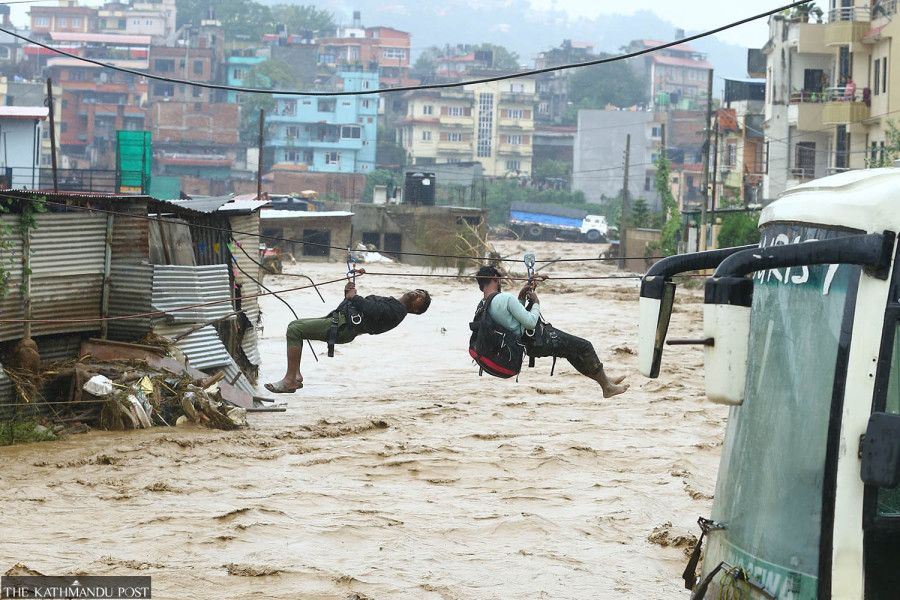Columns
The deluge and state sluggishness
Given the likelihood of heavier rains in the future, we must reconsider our environmental policies.
Madhukar Upadhya
In the last two and a half months, Nepal made global headlines thrice because of major flood disasters, demonstrating how climate change impacts have already engulfed the country. On July 12, a massive debris flow at Simaltal on the Mugling-Narayanghat road swept two night buses, killing 59 passengers. On August 16, glacial lake outburst floods in Solukhumbu damaged several houses in Thame village, home to many famous Sherpa mountaineers and a trekking hub in the Everest region. The third and latest instance was the September 27-28 incessant rains that caused heavy damage to life, infrastructure and property, mostly in central Nepal, including the capital.
Unlike in the case of Simaltal and Solukhumbu, both of which were spontaneous disasters with no forewarning, the Department of Hydrology and Meteorology warned of heavy to hefty rain in central and eastern Nepal on September 27-28 because of an unusual weather system carrying lots of moisture headed towards these regions. With the Simaltal disaster and the subsequently formed task force’s recommendations to avoid such misfortune, which are still presumably fresh in its memory, the government had ample time and knowledge to prepare for the possible worst cases and avoid what was likely to occur following the torrential downpour that had been forecasted. But it failed miserably. The ensuing floods and landslides were devastating.
The recent disaster claimed the lives of 230 people, with many still missing. The resultant landslides have obstructed traffic on all major highways, damaged bridges and large sections of roads, and the inundation of low-lying settlements in the capital has crippled life across the region. The economic loss is reportedly tens of billions of rupees.
The entire saga of the destruction late last month only revealed how feeble our disaster response mechanism has been. It failed to mobilise its gear immediately to save people, keep highways open and rescue the stranded. The worst of it came when a family of four, who had climbed onto the roof of their shanty hut surrounded by the raging Nakkhu River for safety, were swept away by the deluge after awaiting help for hours.
In another incident, a debris flow at Jhyaple Khola along the Tribhuvan highway buried 35 people alive in the vehicles they were travelling in around midnight. They had stopped at a wider corner to await the high-intensity rain to avoid a potential landslide. Thousands on the BP highway had to wade through knee-deep mud for days in the flood-ravaged sections.
If this is what we have to endure during comparatively high rainfall despite the existence of a highly revered institutional setup, laws to steer the government’s disaster response agenda and investments in disaster risk reduction initiatives through mechanisms at all levels of government, including several NGOs working in the area, then we have a long way to go before we're better equipped to handle future disasters.
Why was it so devastating?
Although the weather stations recorded high rainfall, it wasn’t close to other record-breaking events we've witnessed—notably, 540 mm in Kulekhani in 1993 and 624 mm in Dodhara in 2024. Then why was it so devastating this time?
Concurrent factors brought on the devastation. First, the changing pattern of rainfall. Rainfall is changing globally in intensity, patterns and timing, often leading to catastrophic floods. Localised high-intensity rainfall has become the norm. Unfortunately, we don’t have weather stations across every municipality/ward to record real-time rainfall. However, since 2020, we have frequently seen landslides that resulted in heavy casualties and damage to settlements and roads, triggered mainly by high-intensity localised rain.
Second is the sediment load in the rivers. On the night of September 27, high-intensity localised rain in Phulchowki Hill dumped excessive water in all its kholas—the Roshi, the Bhardeo-Nallu, the Lele and the Godawari. The spoil piles left unprotected by stone quarries and the debris from shallow landslides in the head watershed area of the Roshi and Bhardeo-Nallu were swept up by the raging flood. With heavy sediment loads, the Roshi changed its course, wiped out several settlements along its route and pulled down long stretches of the BP Highway. Similarly, the Nallu buried buildings and dumped debris and mud in the valley, particularly the settlements in Nakkhu. The Godawari caused similar damage in the Kathmandu Valley.
Third, debris or mudflows in the mountains. The disaster of Jhyaple Khola was caused by debris flowing from the hill slope covered by trees. There are many examples of debris flow—most of which came from well-protected forest areas—that have buried houses and settlements, killed scores of people and raised questions regarding the role of forests in preventing landslides and floods.
Considering the likelihood of heavier rain in the future, we must revisit our environmental policies. The relevant agencies must examine why seemingly stable slopes turn into debris flow when saturated with rainwater and perhaps address this by working on managing runoff in the hills.
Institutional vacuum
We currently lack public institutions dedicated to developing our national capacity to address floods and landslides, let alone the development of programmes to address them in the context of climate change. The institutions established in the past no longer exist. While restructuring the state, the Department of Soil Conservation and Watershed Management, established in 1974, and the Department of Water-Induced Disaster Management, formerly the Disaster Prevention Technical Center, established in 2000, were merged with other departments, the primary functions of which differ significantly from building local-level capacity in handling floods and landslides.
This institutional restructuring, in turn, limited the scope of national disaster risk reduction efforts, which primarily focus on rescue and relief operations. Floods and landslides, unlike earthquakes, are recurrent and widespread, with larger and lasting cascading impacts. They require a fundamentally different and specialised approach that encourages locals to partner with the national efforts in expediting the crucial groundwork for precautionary measures in the face of disasters. Sadly, this link between the local people and national efforts seems weakened or lost altogether.
Steps forward
Now, the entirety of disaster prevention seems to have become the onus of the government, which is deeply misguided. The recent disaster should convince the authorities that our problems in the coming years will be far worse. The existing response mechanism seemed grievously unfit to withstand the problem. For an effective disaster reduction initiative, we need a self-readying mechanism, which may require the centering of local bodies in disaster reduction initiatives; partnering with civil society organisations, groups and NGOs; promoting volunteers; and monitoring the developing situation after every threatening weather forecast throughout the monsoon period for necessary actions without having to wait for instructions.




 29.12°C Kathmandu
29.12°C Kathmandu















